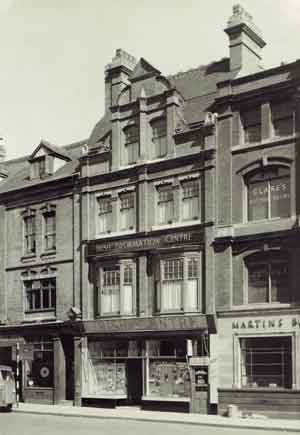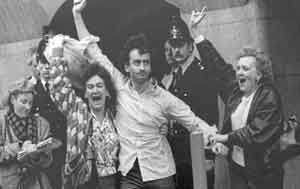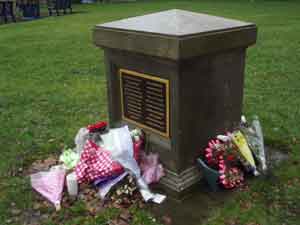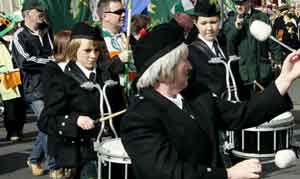By Brian Harvey

What became known as ‘the Troubles’ broke out in Northern Ireland in August 1969. Refugees from the violence soon arrived in Irish advice centres and hostels receiving immigrants in Britain. The first wave went to Birmingham, where 78 families arrived immediately, followed by hundreds more over 1971–2, now going to London as well. Most of the Irish already in Britain were not from Northern Ireland but were ‘Southerners’. Like their counterparts at home, they knew little about the Troubles (1969–98) and saw no reason to get involved, but they soon found themselves in the crossfire. This is their story, as experienced through the eyes of the Irish centres in these two key cities. (For their formation, see my ‘Services for 1950s Irish emigrants’ in HI 30.6, Nov./Dec. 2022, pp 40–3.)
RELIEVING DISTRESS
On 9 September 1969, the Irish Centre in London learned from the Irish embassy that a fund had been started by Irish Unity and the Civil Rights Committee ‘for the relief of distress’ in Northern Ireland. To date, £2,600 had been collected, together with a quantity of clothing. Money and clothing were to be distributed. The next month, October, £250 was duly sent to the Falls Road Relief Fund, £100 to nationalist MP Eddie McAteer and £100 to John Hume. Eddie McAteer subsequently enquired whether the money was for Derry or any part of Northern Ireland, while John Hume likely onforwarded the amount to the Belfast Telegraph relief fund. In January 1972, a further £1,300 was sent to the north: £500 went to Dungannon priest Fr Denis Faul and £500 to the Derry internees dependants fund. In October 1969, the Irish Centre, having learned of the decision of the Irish government to set up a fund for ‘the relief of distress’, several times asked the Irish embassy for some of this funding to ‘relieve distress’ among refugees, but there is no record of a response. The fund subsequently became the stuff of political legend—the Arms Crisis.

The Irish community in Britain was initially little affected during the early years of the Troubles, but travellers passing regularly through the seaports and airports found themselves being checked. Those questioned for more than an hour became Prevention of Terrorism Act (PTA) statistics—80,000 of them, a mere fraction of those who experienced shorter questioning.
DISCRIMINATION AND HARASSMENT
The IRA bombing campaign, which began in 1972, had the immediate effect of exposing Irish centres and hostels in Britain to a barrage of press requests for comment. It also attracted hate mail and phone calls: ‘Whenever a bomb went off, the phone automatically went mad’, said one who worked there. Hostile comment evolved into discrimination and harassment. The Irish community as a whole and its services came under suspicion, the implication being that they might wittingly or unwittingly provide shelter or cover for IRA units operating in Britain. Even the up-market Irish Club was considered suspect. Both Irish and British people stopped coming to Irish centres for events or meetings for fear of consequences.
Early in the Troubles, the police searched the Irish centre in London for two hours. Eventually they found what they thought they were looking for: a list of foreign names, belonging to a priest studying theology there. He was asked whether they were IRA contacts abroad—the Baader-Meinhof gang? The names included Hans Küng, Dietrich Bonhoeffer and many prominent twentieth-century Continental theologians. When this was confirmed, he was released. Another priest recalled a 6am arrival of five police officers who took his diary and papers, though he eventually got them back. Many incidents could not be brushed aside, however, especially when the police identified the wrong person, who might disappear for days in interrogation and then lose his or her job once freed.

Next came bomb scares, then real petrol bombs, to the point that some Irish services asked for and got police protection. The National Front bussed in attackers to target the centres and hostels. The police sometimes arrived frustratingly late, by which time residents had begun to defend themselves by flinging back the Front’s bricks and missiles. There were ugly confrontations, running street battles and bloody injuries. At one hostel the director, who was a priest, had bulletproof glass installed. He invited friendly local people to test it (it passed), but the test backfired when it was inadvertently filmed on television as an attack by a furious, priest-led mob.
The local police in London were invariably helpful, even training centre staff in how to distinguish ‘real’ bombs from hoaxes. Camden Borough Council took discrimination seriously and always investigated. The BBC gave airtime to the centres to explain the vulnerability of the Irish community in Britain, which normally dampened abuse, at least temporarily. The Federation of Irish Services complained about the tone of one of the broadsheets—a story of Irish people swindling British social security of money for IRA funds—and won.
SURVEILLANCE AND INFILTRATION
The real problem for the advice centres were non-local police and the intelligence services. The director of the London service, Fr Jerry Kivlehan, recalled that ‘you often had the sense that you were being watched. There would be a rota of cars with men outside seeing what was going on.’ One weekend, all the centre’s computers were stolen—but they soon turned up handily in the adjacent park, hard drives removed. The police installed cameras to watch people come and go. The centre questioned whether it was really necessary to photograph everyone coming in and out. The considered view of the directors of the services was that they were probably never used by the IRA because this would have been too easily noticed, although one director, Fr Patsy Carolan, recalled that ‘there were some mysterious people who came and went’.
The formal position of the Irish services was one of neutrality. They should welcome anyone—people hurt by the Troubles, loyalist or republican, victims of either side or the authorities—but they soon found themselves setting boundaries. Political organising—never mind arms, weapons and explosives—was prohibited in the hostels. Staff were permitted to search rooms and personal effects. People with strong attitudes arising from the Troubles were welcome, however—‘better that than joining the paramilitaries’. Inevitably, though, there was infiltration by what are now called CHISs (covert human intelligence sources). In one sad case in Birmingham, a CHIS came to the centre director saying that he wanted to give up alcohol. He was too late—his body was found beside the M4 motorway the following day. This was not the only CHIS case. On another occasion, some residents demanded protection money in the name of the IRA, but the director was not convinced that they were who they said they were. Such money was never paid in any case, and nothing further happened.
BOUNDARIES
The political boundaries were indeed difficult to draw, leading to messy compromises. Different centre directors had a range of views on the conflict, some being sympathetic to republicans, others not. The centres permitted ‘civil rights’ and ‘miscarriage of justice’ groups, but not Sinn Féin nor NORAID. Troops Out was a grey area. One centre affiliated itself to the H-blocks committee on humanitarian grounds, which caused much controversy. The manager of a British company with an Irish background, the apolitical John Higgins, had the misfortune to visit the Irish centre at the time of a meeting of a prisoners’ group. The police noted his car registration and informed his employers, and he was summarily dismissed the next day. The practice of reporting people’s car registrations to their employers was insidious, for it often led to the person concerned being sacked. Irish people in the workforce started hitting a glass ceiling, especially those from Northern Ireland, when managers decided that they might be a ‘security risk’. As for John Higgins, he later prospered in business, unlike his former company.

The political boundaries were tested by individual cases. Fr Frank Ryan, the then director of one of the hostel services, Hope House, was approached by a young man looking for the fare back to Belfast to visit his sick father. Fr Ryan gave him £5, but found out weeks later that the young man, Gerard Conlon, had been arrested for the Guildford pub bombings (one of the Guildford Four). The police came to the hostel to take away its records. Fr Ryan suggested to the police that the IRA would hardly leave a crack bomber stranded in London begging a fare back to Belfast from a priest. To complicate things, Gerard Conlon’s father, who had indeed been ill, came to London to stay with his sister, Anne Maguire. The police then interrogated her, carried out forensic tests and decided that she and six others were running a bomb factory, for which they were convicted (the Maguire Seven). Hope House was named in the papers as the bomber’s base, making it a public landmark, inviting retaliation from loyalists or the National Front or both, so it was renamed Conway House after the cardinal.
Convinced that Gerard Conlan was an unlikely bomber, the hostel approached Irish businesses to fund buying a computer to help reconstruct hostel records that could corroborate Conlon’s time there or not; none responded, however, so the residents agreed to a rent increase of 30p a week to fund it. Ultimately, new witnesses were found, flaws in the investigation were identified and the Guildford Four were eventually freed in 1989 and the Maguire Seven in 1991.
BIRMINGHAM BOMBS
In Birmingham, Irish services initially carried on unaffected by the Troubles; the St Patrick’s Day parade continued to be a high point in the city’s festival calendar. This changed when the IRA bombing campaign there began in 1973, especially the pub bombings of 18 November 1974, which left 183 casualties—21 dead (including three Irish people) and 162 injured. No amount of condemnation by the Irish community could stop the subsequent attacks on Irish services and even Catholic schools. Many Irish workers were dismissed summarily from their jobs the next day. The Irish centre in the city closed temporarily. Six men were arrested, later called the ‘Birmingham Six’, but the arrests of such long-standing, well-integrated members of the Irish community convinced local opinion that ‘no Irish person could be trusted’. Many Irish people had their windows broken, an event compared to Kristallnacht in Germany in 1938. Some British employers went to great lengths to ensure that there were no reprisals in their workplaces, but they were few and far between.
The Irish community was trebly angry—with the IRA for launching the campaign; with their neighbours, for their re-aroused colonial prejudices; and with the police, who, having arrested the ‘Birmingham Six’, stopped looking for the real bombers, who were free to carry on. According to the Irish centre director of the time, Fr Paddy Sheridan, the event ‘nearly killed off the Irish community in the city’. The St Patrick’s Day parade was cancelled indefinitely. The most common response of members of the Irish community was to make themselves invisible. Many felt uneasy about their accent in the city: ‘You’d be afraid to speak loudly on the buses or the streets’. Sr Dympna O’Driscoll recalled that ‘you might not get overt antagonism, but people could be just cold and not friendly’. Irish cultural activities decreased or kept a low profile. According to Fr Paddy Sheridan, ‘the police completely lost their head’ in their determination to arrest anyone. He tried many times to visit the ‘Six’, as did an Anglican clergyman, but this was always refused, which was most unusual. Eventually there was a successful appeal in 1991.
ST PATRICK’S DAY, 1996

St Patrick’s Day, 17 March 1996, was the landmark event that marked the end of the Troubles in Birmingham. The director of the Irish centre, Fr Joe Taaffe, took the view that the Irish community should not keep its head down forever. To test the waters, there was an Irish Festival, a £25,000 event (the city contributed £5,000) lasting four days, with hurling, football, folk groups and rock bands, with its centre-piece a nostalgic recreation of a 1940s kitchen. Then the Irish parade returned with an open-top bus; it soon attracted 80,000 people, becoming the third biggest in the world and a money-spinner for the city.
When Irish emigrant services were set up in London in 1948 and in Birmingham in 1957, no one could have imagined that events in Northern Ireland would subject them to such a severe test. It was not as if, like de Valera in the Second World War, they could simply ‘declare neutrality’, although they tried. They were caught up in the Troubles, whether they wished it or not. They received the first refugees, then the victims of the paramilitaries and the security forces, and continued to welcome people from Northern Ireland looking for advice or accommodation. They were tested by infiltrators from both sides, police surveillance and miscarriage-of-justice cases. Although some British authorities, employers and police emerged well from these events, others did not. The Irish community in Britain suffered greatly from the IRA’s bombing campaign, especially in the workforce and in its social life, a sometimes-overlooked casualty of ‘the Troubles’.
Brian Harvey is an independent social researcher.
Further reading
G. Harrison, The scattering: a history of the London Irish Centre, 1954–2004 (London, 2004).
P. Kennedy, Welcoming the stranger—Irish migrant welfare in Britain since 1957 (Sallins, 2015).
